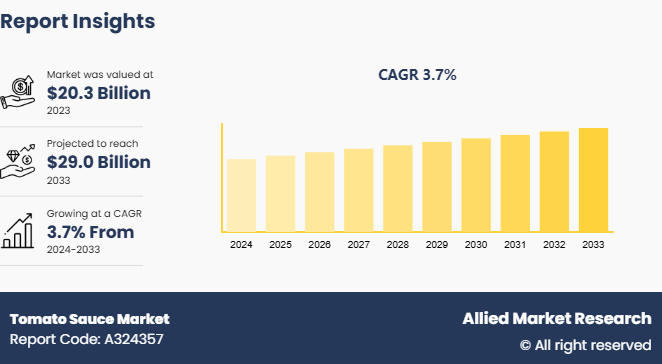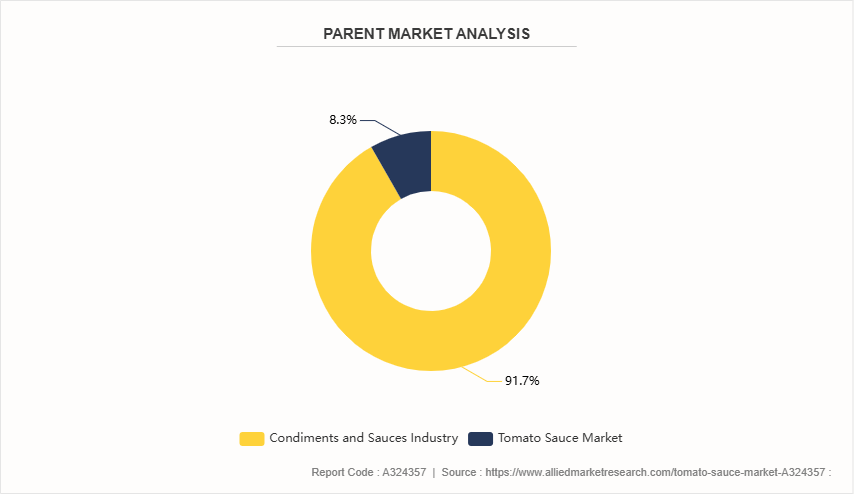Tomato Sauce Market Research, 2033
Market Introduction and Definition
The global tomato sauce market size was valued at $20.3 billion in 2023, and is projected to reach $29.0 billion by 2033, growing at a CAGR of 3.7% from 2024 to 2033.The global market for tomato sauces is the industry that produces, distributes, and consumes sauces derived mostly from tomatoes that are frequently used in a wide range of culinary preparations. The usual method for making tomato sauce is to cook tomatoes down, frequently with herbs, spices, and other flavorings, until the sauce is smooth or chunky. Pasta, pizza, and stews are just a few of the many foods prepared using it. The market is fueled by factors like shift in consumer tastes, a rise in the desire for convenience food, and the expanding appeal of Italian food across the globe. The market serves the retail and restaurant industries with a variety of product forms, such as sauces in bottles, cans, and pouch packs.

Key Takeaways
- The tomato sauce market study covers 20 countries. The research includes a segment analysis of each country in terms of value for the projected period.
- More than 1, 500 product literature, industry releases, annual reports, and other such documents of major tomato sauce industry participants along with authentic industry journals, trade associations' releases, and government websites have been reviewed for generating high-value industry insights.
- The study integrated high-quality data, professional opinions and analysis, and critical independent perspectives. The research approach is intended to provide a balanced view of global markets and to assist stakeholders in making educated decisions in order to achieve their most ambitious tomato sauce market growth objectives.
Key market dynamics
A major factor is consumer preference since changing eating patterns raise demand for low-sugar, organic, and healthier options. In the market, tomato sauces made entirely of natural ingredients without the use of artificial coloring or preservatives are becoming more popular as consumers grow more health conscious. Furthermore, the market for tomato sauce is expected to rise due to the rising demand for convenience food, such as prepared meals and ready-to-eat products. These products are frequently used in many different types of food, especially in processed food, fast food, and restaurant dishes.
Another important factor is the globalization of food culture. The tomato sauce market demand like marinara and salsa is continuously increasing as international cuisines like Italian and Mexican continue to gain appeal, particularly in metropolitan areas. This has helped the company to grow across regions like Asia-Pacific, where there is a growing impact of Western cuisine.
Another important factor is product offerings and packaging innovation. The rise of environmentally friendly packaging and creative, user-friendly designs, including single-serve packs or squeezable bottles, meets the changing demands of consumers who are constantly on the go. Additionally, producers are broadening their product offerings to accommodate particular tastes, such as vegan or low-sodium options.
Additionally, distribution channels are growing, becoming more prevalent in both traditional retail and e-commerce platforms. A wider range of tomato sauce brands and products are now more easily accessible due to the growing popularity of online grocery shopping. Furthermore, niche companies emphasizing flavor and quality have emerged as a result of the growing demand for artisanal and high-end products. Thus, the market is defined by a combination of mass-market products and specialty, high-end alternatives.
Parent Market Overview of the Global Tomato Sauce Market

The growing demand for processed food, convenience food, and multipurpose cooking ingredients is driving expansion in the condiments and sauces industry, of which the global tomato sauce market is a significant part. In addition, due to its extensive use in food like pasta, pizza, and burgers, tomato sauce is a mainstay in many different cuisines. Consumer preferences for healthier products, such as low-sodium and organic sauces, have an impact on the market. Demand is also being driven by the growing popularity of ethnic cuisines, fast food, and home cooking. The development of the market is also significantly influenced by the expansion of retail and the growth of e-commerce platforms.
Market Segmentation
The tomato sauce market is segmented into type, packaging, sales channel, and region. On the basis of type, the market is divided into flavored, regular, and others. On the basis of packaging, the market is classified into pouch, bottle, and others. On the basis of sales channel, the market is categorized into supermarkets/hypermarkets, convenience stores, specialty stores, online, and others. Region-wise, the market is analyzed across North America, Europe, Asia-Pacific, and LAMEA.
Regional/Country Market Outlook
The growing need for convenience food, ready-to-eat meals, and adaptable condiments is propelling the global tomato sauce market's notable expansion throughout several regions. The market is still dominated in North America, especially in the U.S., where tomato sauce is a common ingredient in pizza, pasta, and burgers. The increased number of health-conscious consumers has led to a desire for organic and low-sodium varieties. Additionally, market expansion in this region is fueled by the appeal of ethnic cuisines like Mexican and Italian.
Countries such as Italy, Spain, and the UK are major contributors to the tomato sauce market in Europe. Sauce is a staple of Italian cuisine, which is renowned for its culinary heritage and continues to be a major producer and consumer of tomato-based products. The increasing popularity of home cooking and the growth of food product e-commerce both contribute to the expansion of this market in this region. Since customers in Western Europe are looking for cleaner-label, higher-quality products, there has been an increase in demand for premium, organic, and artisan tomato sauces.
The market for tomato sauce is growing in the Asia-Pacific region due to shifting dietary habits and rising westernization, particularly in nations like China and India. Despite not being a traditional component of Asian cuisine, tomato sauce is increasingly being used in processed foods and fast food. The popularity of sauces and condiments used in regional food like tacos and burgers, which has a major impact on the demand for tomato sauce throughout Latin America. Similar to this, tomato sauces are becoming more well-liked throughout the Middle East as a result of their application in regional and international fusion cuisine. As a result, the tomato sauce market is expected to keep growing across geographical boundaries due to reasons like convenience, change in consumer preferences, and rise in demand for international cuisines.
Industry Trends:
- Heinz responded to the increased customer demand for clean-label and organic food products in August 2024 by launching a new line of organic tomato sauces in the U.S. By taking this action, Heinz increased tomato sauce market share in the premium condiment market and targeted health-conscious consumers.
- Yihai Kerry Arawana built a new tomato sauce processing facility in Guangdong province in July 2024, increasing its manufacturing capacity in China. Meeting the growing demand for ready-to-use sauces in both domestic and foreign markets is the goal of this growth.
- A new range of tomato-based sauces with Asian spices was introduced by McCormick in June 2024, capitalizing on the expanding fusion cuisine movement in the Asia-Pacific region.
- A new low-sodium tomato sauce product was launched by Del Monte Foods in the U.S. in May 2024 to satisfy the growing demand from health-conscious consumers for products with less salt.
- Nestlé China launched a new premium tomato sauce in April 2024 that was created especially for the local Chinese palate and featured a special blend of spices. The product seeks to appeal to the growing middle class, which is looking for more upscale and gourmet condiments.
- A gluten-free tomato sauce version was introduced in the U.S. market by Classico, a division of Kraft Heinz, in March 2024 to accommodate the growing number of customers on gluten-free diets.
Competitive Landscape
The major players operating in the tomato sauce industry include Botton Group S.r.l, CREMICA FOOD INDUSTRIES LTD, Del Monte Foods, Inc., Everest Food, General Mills Inc., KRAFT Foods, Lee Kum Kee, Nestle SA, Premier Foods Limited, and Unilever.
Recent Key Strategies and Developments
- In February 2024, a local Chinese tomato sauce manufacturer was purchased by Bright Food Group to broaden its product line and distribution network. Strengthening its position in the very competitive Chinese condiment sector is the goal of the acquisition.
- In January 2024, in the Asia-Pacific region, Unilever started a new environmentally friendly packaging campaign for its tomato sauce products. Through the promotion of recyclable materials in packaging and the reduction of plastic consumption, this strategy seeks to be in line with sustainability trends.
Key Benefits For Stakeholders
- This report provides a quantitative analysis of the tomato sauce market size, segments, current trends, estimations, and dynamics of the tomato sauce market analysis from 2024 to 2033 to identify the prevailing tomato sauce market opportunities.
- The market research is offered along with information related to key drivers, restraints, and opportunities.
- Porter's five forces analysis highlights the potency of buyers and suppliers to enable stakeholders make profit-oriented business decisions and strengthen their supplier-buyer network.
- In-depth analysis of the tomato sauce market segmentation assists to determine the prevailing market opportunities.
- Major countries in each region are mapped according to their revenue contribution to the global tomato sauce market share.
- Market player positioning facilitates benchmarking and provides a clear understanding of the present position of the market players.
- The report includes the analysis of the regional as well as global tomato sauce market trends, key players, tomato sauce market forecast, application areas, and tomato sauce market growth strategies.
Tomato Sauce Market Report Highlights
| Aspects | Details |
| Market Size By 2033 | USD 29.0 Billion |
| Growth Rate | CAGR of 3.7% |
| Forecast period | 2024 - 2033 |
| Report Pages | 250 |
| By Type |
|
| By Packaging |
|
| By Sales Channel |
|
| By Region |
|
| Key Market Players | Lee Kum Kee, Everest Food, Unilever, Botton Group S.r.l, General Mills Inc., Nestle SA, Premier Foods Limited, CREMICA FOOD INDUSTRIES LTD, Kraft Foods, Del Monte Foods, Inc. |
Upcoming trends in the global tomato sauce market include increasing demand for organic products, convenience packaging, healthier options with reduced sugar and salt, plant-based innovations, and growing popularity in emerging markets.
The leading application of the tomato sauce market is in the food and beverage industry, primarily used in cooking, as a condiment, and in ready-to-eat meals, especially pizzas and pastas.
The largest regional market for tomato sauce is North America, driven by high consumer demand, extensive distribution networks, and strong market presence of leading brands in the U.S. and Canada.
The global tomato sauce market was valued at $20.3 billion in 2023, and is projected to reach $29.0 billion by 2033, growing at a CAGR of 3.7% from 2024 to 2033.
The major players operating in the tomato sauce market include Botton Group S.r.l, CREMICA FOOD INDUSTRIES LTD, Del Monte Foods, Inc., Everest Food, General Mills Inc., KRAFT Foods, Lee Kum Kee, Nestle SA, Premier Foods Limited, and Unilever.
Loading Table Of Content...



